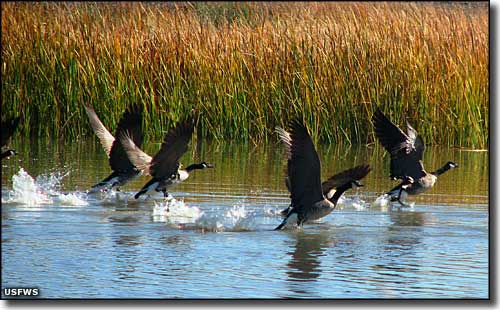Biological Hazard in USA on Wednesday, 12 October, 2011 at 03:24 (03:24 AM) UTC. |
| Description |
A total of 2,356 birds have died as a result of an avian botulism outbreak at the Six Man Club south of Naval Air Station Fallon, according to the U.S. Fish and Wildlife Service. The botulism, which does not affect humans, emerged from one of the ponds at the private hunting club due to hot weather and stagnant water in August. Since then, the outbreak has spread to all 10 ponds at the club and has killed ducks, ibis and numerous other species including a red-tailed hawk. According to Kyle Neill of the Nevada Department of Wildlife, 1,339 ducks and 755 coots have died as a result of the outbreak. He added 414 birds have died since Friday. The outbreak has not spread to Stillwater National Wildlife Refuge or Carson Lake, according to the USFWS. According to state records, this could be one of the worst botulism outbreaks since 1949. According to Mike Goodard of the USFWS, teams of individuals from the service and the Nevada Department of Wildlife have been on-site to clean up the dead birds. The U.S. Fish and Wildlife Service and NDOW teams use air boats to roam the ponds and scoop of birds with fishing nets. Goodard said no one from the Six Man Club has joined in the recovery efforts.
On Friday, more than 200 dead birds were found and removed to one of several pits on the property. In addition, the USFWS has created a “Duck Hospital” at Stillwater National Wildlife Refuge and also has another pit for dead birds. The one open pit at the club was about 5 feet deep and 8 feet in length and littered with hundreds of carcasses with thousands of flies swarming the bodies. The other pits on the property had been filled with dirt to cover the carcasses. Bill Henry, a wildlife biologist for the USFWS, said the botulism originated from the ground, where it became active once the first pond was filled with water. The water, which remained stagnant, became warm due to hot summer temperatures. “All this good habitat is causing all this death,” Henry added. The botulism then moved into the drinking source for the birds and once the initial birds died, flies laid eggs, which soon became maggots. Henry said the maggots can ingest the botulism without being affected, but the birds will eat the maggots, become infected and eventually die if they are not rescued in time. He added the disease creates paralysis starting with the feet and then moves to the body and eventually the head and neck. The result of death is by drowning or heat exhaustion, Henry said. He added it can take less than 12 hours for a healthy bird to ingest water or maggots before dying.
However, many ill birds have been saved at the refuge's “Duck Hospital.” Clean and cool water flushes the botulism out of the birds' system. Eventually the birds are released back into the wild. But the crux of the outbreak, according to USFWS officials, has been the approach by the Six Man Club. Goodard said the service contacted the club when the outbreak originated and recommended draining the pond. Instead, the club used its water allotment to fill the nine other ponds in an attempt to cool the infected pond and erase the botulism. However, that maneuver backfired and the outbreak has spread to all 10 ponds. “We suggested to drain the pond, but other choices were made,” Henry said. Goodard and Henry said they have not been in contact with the club's owners and that another recommendation to haze — or scare — birds away has fallen on deaf ears. Federal and state officials have tried to keep birds away from the ponds, but the vast size of the club makes the project difficult. Chris Nicolai, a migratory bird biologist for the USFWS said an outbreak in 1988 claimed 6,000 to 10,000 birds. He added last that Thursday and Friday were the worst two days since the outbreak began with more than 400 dead birds collected. To stop the spread of botulism, Goodard said cool weather is needed to drop the water temperature in the ponds. The forecast for this week calls for temperatures in the mid-70s with evening lows in the high 30s to low 40s.
The water fowl hunting season opens Saturday. “Thursday might be our last day (cleaning up),” Neill added. “It's toned down the last couple days and hopefully the weather stays cool.” Clostridium botulinum, or avian botulism, is the cause of the current outbreak at the Six Man Club south of Naval Air Station Fallon. It affects water fowl and shorebirds. The bacteria is widespread in soil and requires warm temperatures, a protein source and an anaerobic (no oxygen) environment in order to become active and produce toxin. Decomposing vegetation and invertebrates combined with warm temperatures can provide ideal conditions for the botulism bacteria to activate and produce toxin. |
| Biohazard name: | Avian botulism |
| Biohazard level: | 2/4 Medium |
| Biohazard desc.: | Bacteria and viruses that cause only mild disease to humans, or are difficult to contract via aerosol in a lab setting, such as hepatitis A, B, and C, influenza A, Lyme disease, salmonella, mumps, measles, scrapie, dengue fever, and HIV. "Routine diagnostic work with clinical specimens can be done safely at Biosafety Level 2, using Biosafety Level 2 practices and procedures. Research work (including co-cultivation, virus replication studies, or manipulations involving concentrated virus) can be done in a BSL-2 (P2) facility, using BSL-3 practices and procedures. Virus production activities, including virus concentrations, require a BSL-3 (P3) facility and use of BSL-3 practices and procedures", see Recommended Biosafety Levels for Infectious Agents. |
| Symptoms: | |
| Status: | confirmed |
|
http://www.lahontanvalleynews.com |
|
 
 |
| USFWS |
|
|




No comments:
Post a Comment